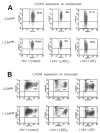Inhibition of HIV type 1 replication in CD4+ and CD14+ cells purified from HIV type 1-infected individuals by the 2-5A agonist immunomodulator, 2-5A(N6B)
- PMID: 17263642
- PMCID: PMC1941645
- DOI: 10.1089/aid.2005.0091
Inhibition of HIV type 1 replication in CD4+ and CD14+ cells purified from HIV type 1-infected individuals by the 2-5A agonist immunomodulator, 2-5A(N6B)
Abstract
Two major interferon (IFN)-mediated antiviral defense enzymes are double-stranded (ds)RNA-dependent 2',5'-oligoadenylate (2-5A) synthetase (2-5OAS) and p68 kinase (PKR). When activated by dsRNA, 2-5OAS synthesizes 2-5A, which binds to and activates RNase L. Activated RNase L hydrolyzes single-stranded viral RNA, thereby inhibiting viral protein synthesis. HIV-1 inhibits the IFN-mediated intracellular antiviral pathways. We have reported the synthesis and characterization of a nuclease-resistant 2-5A agonist (2-5A(N6B)) that overcomes the HIV-1 induced blockades by restoring the 2-5OAS/RNase L antiviral pathway (Homan JW, et al., J Acquir Immune Defic Syndr 2002;30:9-20). The objective of this study was to test the effect of 2-5A(N6B) on chronically infected CD4(+) T lymphocytes and CD14(+) monocytes derived from HIV-1-seropositive individuals. Wild-type HIV-1 replication was effectively inhibited by 2-5A(N6B) in CD4(+) T lymphocytes and CD14(+) monocytes purified from HIV-1 seropositive individuals (n = 18) compared to untreated cells. We also assessed the cytotoxicity of 2-5A(N6B) and report that 2-5A(N6B) exerts its anti-HIV-1 activity with no evidence of cytotoxicity (IC(90) > 100,000 nM). Furthermore, 2-5A(N6B) did not alter the cellular RNA profile, affect CCR5 or CXCR4 coreceptor expression, or activate caspase-dependent apoptosis. Evidence is also provided to show that 2-5A(N6B), and naturally occurring 2-5A(4), act as ligands to activate human Toll-like receptor 4. These results indicate that the 2-5A agonist 2-5A(N6B) has the potential to enhance host cell innate and acquired immune defense mechanisms against HIV-1 infection.
Figures







Similar articles
-
Inhibition of morphine-potentiated HIV-1 replication in peripheral blood mononuclear cells with the nuclease-resistant 2-5A agonist analog, 2-5A(N6B).J Acquir Immune Defic Syndr. 2002 May 1;30(1):9-20. doi: 10.1097/00042560-200205010-00002. J Acquir Immune Defic Syndr. 2002. PMID: 12048358
-
The 2-5A system and HIV infection.Prog Mol Subcell Biol. 1994;14:176-97. doi: 10.1007/978-3-642-78549-8_10. Prog Mol Subcell Biol. 1994. PMID: 7914804 Review.
-
Phosphorothioate and cordycepin analogues of 2',5'-oligoadenylate: inhibition of human immunodeficiency virus type 1 reverse transcriptase and infection in vitro.Proc Natl Acad Sci U S A. 1989 Sep;86(18):7191-4. doi: 10.1073/pnas.86.18.7191. Proc Natl Acad Sci U S A. 1989. PMID: 2476814 Free PMC article.
-
Hydroxychloroquine drastically reduces immune activation in HIV-infected, antiretroviral therapy-treated immunologic nonresponders.Blood. 2011 Sep 22;118(12):3263-72. doi: 10.1182/blood-2011-01-329060. Epub 2011 May 16. Blood. 2011. PMID: 21576701
-
(2'-5')Oligoadenylate and intracellular immunity against retrovirus infection.Int J Biochem. 1992;24(1):55-63. doi: 10.1016/0020-711x(92)90229-t. Int J Biochem. 1992. PMID: 1374726 Review.
Cited by
-
Ribonuclease L is not critical for innate restriction and adaptive immunity against Friend retrovirus infection.Virology. 2013 Aug 15;443(1):134-42. doi: 10.1016/j.virol.2013.05.009. Epub 2013 May 29. Virology. 2013. PMID: 23725696 Free PMC article.
-
Occludin regulates HIV-1 infection by modulation of the interferon stimulated OAS gene family.Res Sq [Preprint]. 2023 Jan 30:rs.3.rs-2501091. doi: 10.21203/rs.3.rs-2501091/v1. Res Sq. 2023. Update in: Mol Neurobiol. 2023 Sep;60(9):4966-4982. doi: 10.1007/s12035-023-03381-0. PMID: 36778388 Free PMC article. Updated. Preprint.
-
Mouse knockout models for HIV-1 restriction factors.Cell Mol Life Sci. 2014 Oct;71(19):3749-66. doi: 10.1007/s00018-014-1646-8. Epub 2014 May 23. Cell Mol Life Sci. 2014. PMID: 24854580 Free PMC article. Review.
-
Mechanisms employed by retroviruses to exploit host factors for translational control of a complicated proteome.Retrovirology. 2009 Jan 24;6:8. doi: 10.1186/1742-4690-6-8. Retrovirology. 2009. PMID: 19166625 Free PMC article. Review.
-
Robert J. Suhadolnik (1925-2016).J Interferon Cytokine Res. 2016 May;36(5):277-8. doi: 10.1089/jir.2016.29001.rjs. J Interferon Cytokine Res. 2016. PMID: 27119566 Free PMC article. No abstract available.
References
-
- Sen GC. Viruses and interferons. Annu Rev Microbiol. 2001;55:255–281. - PubMed
-
- Goodbourn S, Didock L, Randall RE. Interferons: cell signaling, immune modulation, antiviral responses and virus countermeasures. J Gen Virol. 2000;81:2341–2364. - PubMed
-
- Stark GR, Kerr IM, Williams BR, et al. How cells respond to interferons. Annu Rev Biochem. 1998;67:227–264. - PubMed
-
- Dong B, Silverman RH. 2–5A-dependent RNase molecules dimerize during activation by 2- 5A. J Biol Chem. 1995;270:4133–4137. - PubMed
Publication types
MeSH terms
Substances
Grants and funding
LinkOut - more resources
Full Text Sources
Other Literature Sources
Medical
Research Materials

